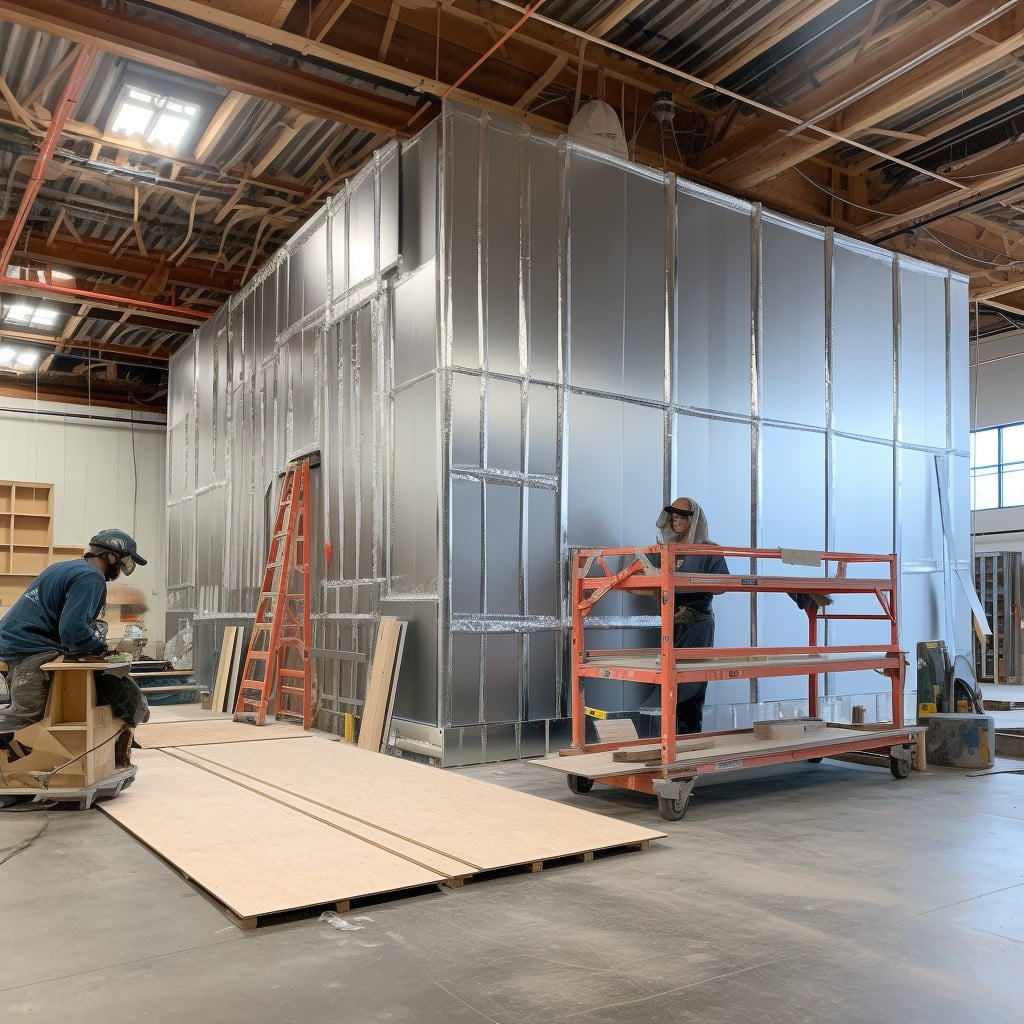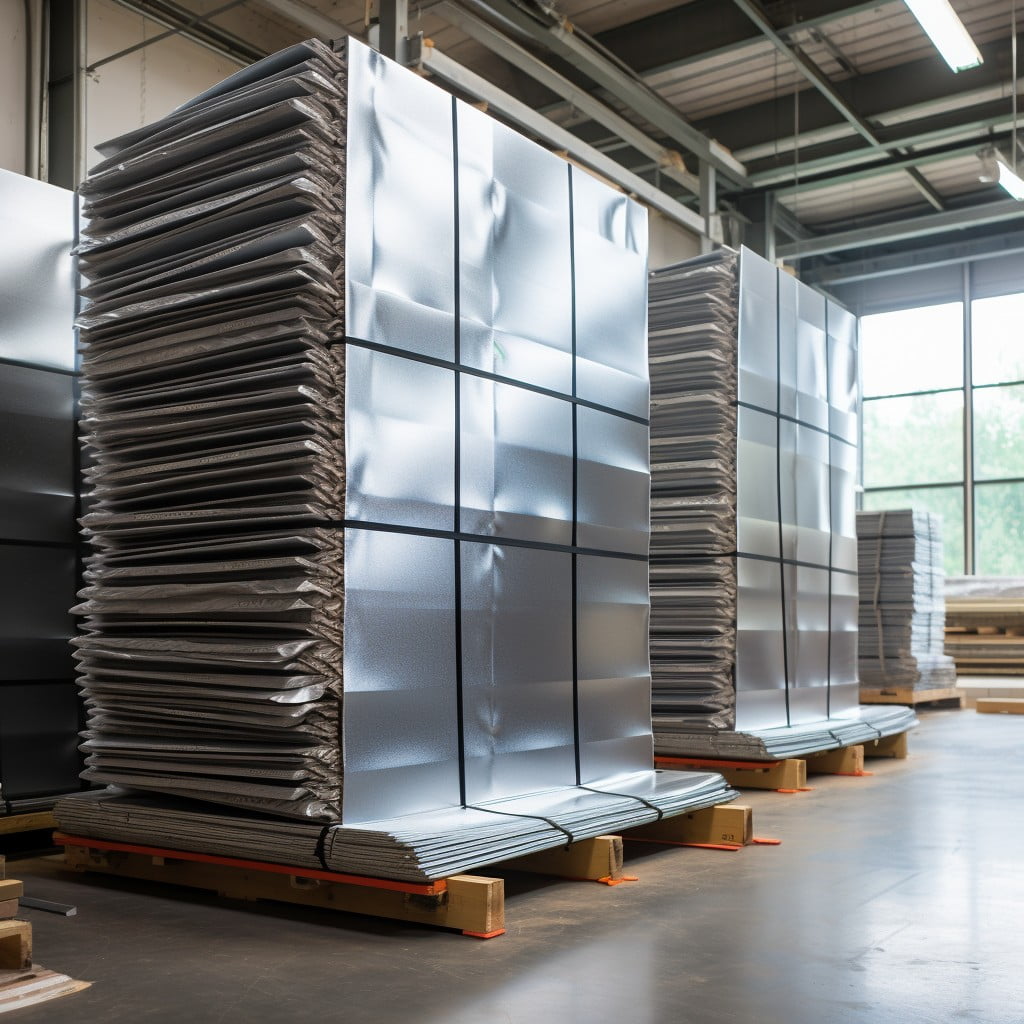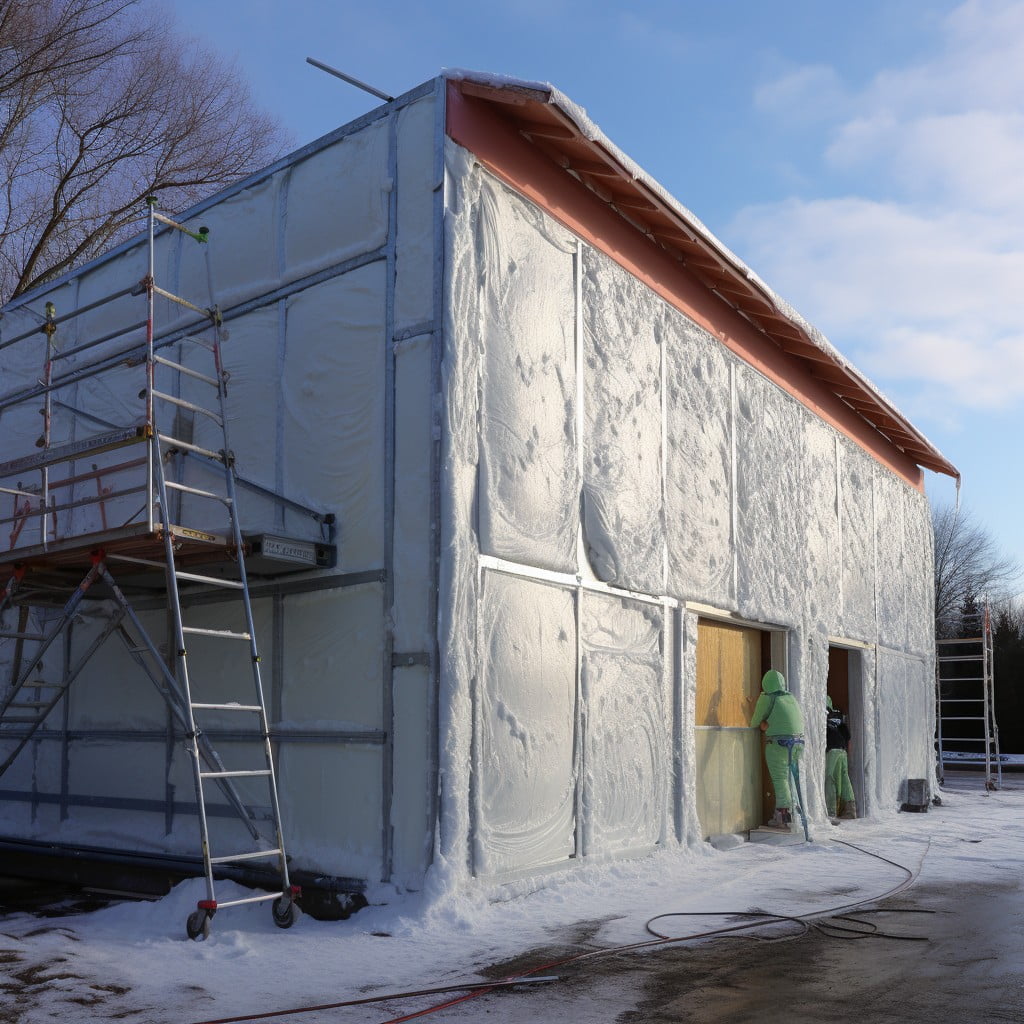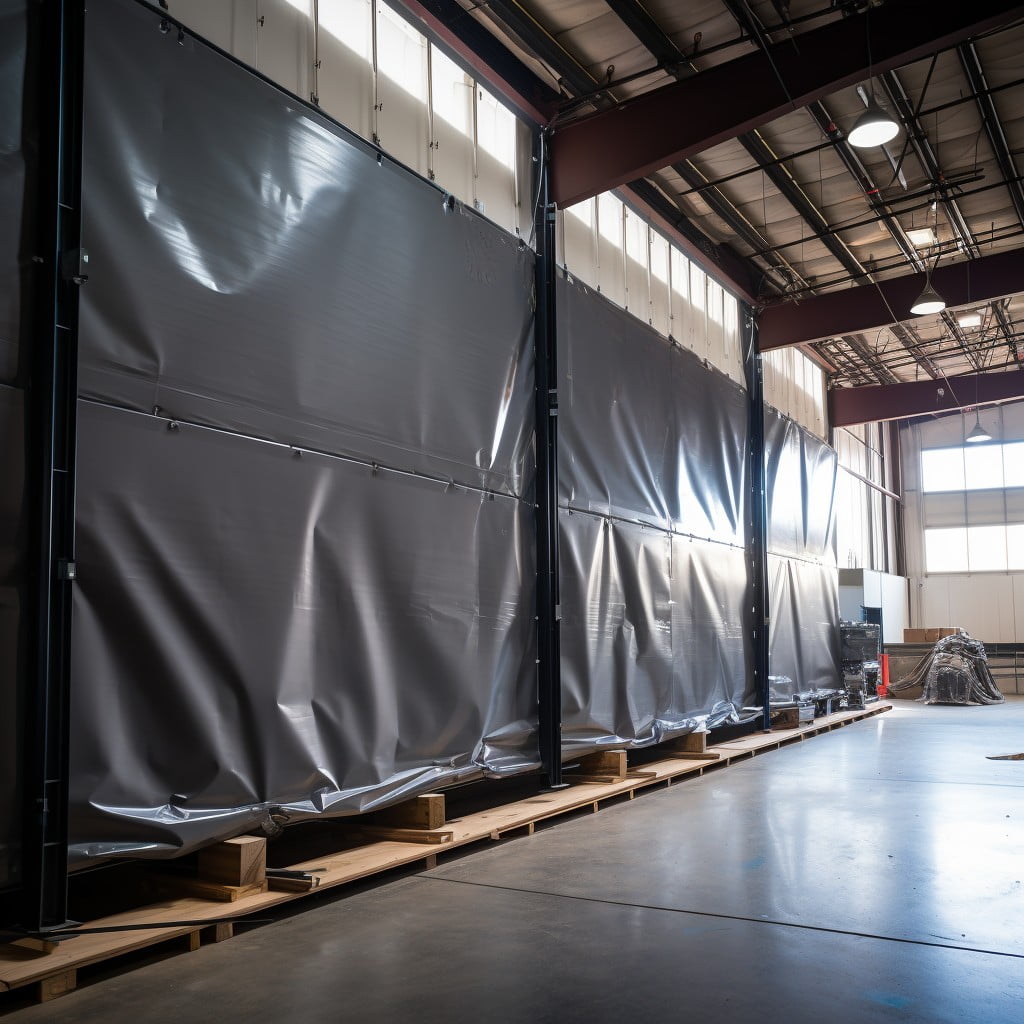Explore practical techniques and materials to effectively soundproof your metal building for enhanced acoustics and privacy.
Soundproofing a metal building is an effective way to reduce noise pollution and improve acoustics. This process involves several steps, including the use of insulation materials, soundproofing sealants, and specialized construction techniques.
Whether you’re looking to create a peaceful workspace or a quiet living area, soundproofing your metal building can provide a significant improvement. In this article, we delve into the specifics of each step, offering detailed guidance on materials, methods, and best practices to ensure your soundproofing project is a success.
Key takeaways:
- Density, STC, NRC, flammability, and sustainability are important factors when choosing soundproofing materials.
- Foam and fiberglass insulation are popular choices for soundproofing metal buildings.
- Vinyl sound barriers are effective in reducing sound transmission.
- Acoustic tiles and foam panels absorb sound waves for improved acoustics.
- Soundproofing the flooring and sealing cracks and crevices are essential to reducing noise leakage.
How Is Metal Different From Other Types of Construction?

Metal construction offers unique advantages, especially in terms of strength, durability, and speed of construction. Unlike traditional wooden structures, metal buildings are incredibly resistant to environmental conditions, pests, and even fire damage. Moreover, their modular nature allows for quick and efficient assembly.
However, their acoustical properties pose certain challenges. The echoey nature of metal can amplify sounds, making these structures potentially noisier than their wood or brick counterparts. Also, metal’s highly conductive nature means it can transmit sound waves across walls and floors more easily, contributing to unwanted noise leakage. Dealing with these specific characteristics determines the choice of soundproofing techniques and materials. We’ll learn about this in the following sections.
Choosing the Right Soundproofing Material

Given the multitude of options, selecting the appropriate soundproofing material is crucial. While all materials aim to minimize noise transmission, they work differently and provide varying levels of reduction. Evaluate the particular needs of your metal building before deciding.
1. Density: The denser the material, the better it is at blocking sound waves. Consider the materials’ thickness along with their densities.
2. Transmission Class (STC): STC is a measure of a material’s ability to reduce sound transmission. Higher STC ratings indicate greater sound insulating capabilities.
3. Noise Reduction Coefficient (NRC): The NRC tells you how much sound an object can absorb. Higher NRC values represent better sound absorption qualities.
4. Flammability Ratings: Given that metal buildings are highly susceptible to heat, soundproofing material with good fire resistance properties is recommended. Check the manufacturer’s flammability ratings.
5. Sustainability: If environmental impact is a concern, opt for recyclable, low VOC emission materials, which also ensures better indoor air quality.
Remember, the material that works best will depend on the specific soundproofing requirement in your metal building. Doing some research based on these points can help ensure you make an informed decision.
Foam or Fiberglass Insulation

Both foam and fiberglass are popular choices for soundproofing purposes due to their excellent absorption capabilities. Foam insulation, available in spray form, creates a tight seal when applied. It’s particularly efficient in preventing sound transmission through tiny gaps or cracks. Alternatively, fiberglass insulation, while less effective in creating an air-tight environment, has proven effective in absorbing airborne sound waves.
You have eco-friendly options as well, such as cellulose insulation made of recycled paper. A crucial note here is the thickness of the material affects the degree of soundproofing. More thickness results in improved noise reduction.
Remember, installation plays a key role in the effectiveness of these materials. Poorly installed insulation can result in sound leakage, much like a badly sealed door. In the case of spray foam insulation, it expands after application, filling up spaces for a complete seal. But, caution must be taken to let it dry thoroughly before installing the walls over it.
In summary, each insulation material has its strengths and is more appropriate for certain situations. It’s essential to choose based on your particular needs and consult a professional if necessary.
Vinyl Sound Barriers

These barriers work wonders in impeding the transmission of sound. Made from dense, flexible material, they consist of thin, rolled sheets that can be cut to the desired size and applied on the walls, ceilings, or floors. They form an extra layer to your structures, breaking the sound’s pathway, hence reducing the noise.
They typically have high Sound Transmission Class (STC) ratings, meaning they are quite effective in blocking sound. Although they’re dense, vinyl sound barriers remain flexible, which makes installation less cumbersome, and they don’t compromise space within your building.
For better performance, it’s advisable to combine them with other soundproofing materials such as foam or fiberglass insulation. It’s important to note that the effectiveness of vinyl sound barriers largely depends on their proper installation. Attention to detail, such as sealing around the edges and overlap areas, can significantly enhance their soundproofing effectiveness.
Acoustic Tiles and Foam Panels
High-performing options for reducing noise are acoustic tiles and foam panels. These products work on a central principle: sound absorption. Instead of simply blocking sound, they absorb echoing sound waves in a room, creating a quieter atmosphere.
Acoustic tiles are lightweight, easy to install, and can fit directly into drop-ceiling grids or mounted on walls using adhesive. For more effectiveness, opt for tiles with a high Noise Reduction Coefficient (NRC).
Foam panels, on the other hand, are perfect for covering larger areas. They use microscopic open cells to trap sound waves. Panels come in varying thicknesses, with thicker options offering greater absorption capacity. It’s important to place these as closely as possible to the sound source for optimal performance.
Both these materials come in a variety of colors and designs, allowing them to serve both functional and aesthetic purposes in a room.
Choosing between acoustic tiles and foam panels will depend on the particular soundproofing needs of your metal building and the preferred aesthetic look. Remember, fitting and installation are keys to ensuring any soundproofing method works effectively.
Sound-Absorbing Blankets
Constructed from thick textile material with superior noise absorbing capabilities, these blankets can make a huge difference in a metal building. They work by soaking up the sound waves that come into contact with them, mimicking the effects of soft furnishings in a room.
They’re typically hung on walls, from ceilings – anywhere sound is bouncing off hard surfaces. Sound-absorbing blankets can be particularly effective when used in conjunction with other soundproofing methods, like foam or fiberglass insulation.
Moreover, these blankets come with the added benefit of being portable. You can reposition them with ease, targeting the specific areas where noise pollution is a concern. They also come in an array of colors and patterns, providing both a practical and aesthetic addition to your space.
Soundproofing the Flooring
If overlooked, floors can become a significant avenue for noise transmission in metal buildings. Let’s delve into how you can effectively mitigate this.
Use thicker flooring materials: By opting for thicker materials such as vinyl or rubber, a certain level of impact sound can be absorbed, reducing noise transfer.
Incorporate underlayment: An acoustic underlayment, like a rubber mat, can be installed under your floor. This not only helps absorb impact noise but also improves your building’s thermal insulation.
Install carpeting or rugs: Adding soft surfaces, like carpets or rugs, over hard flooring raises the absorption level of impact sounds. They are effective, easy to install, and also enhance the aesthetics of your space.
Opt for floating floors: In this setup, flooring materials are not directly attached to the sub-floor which significantly cuts down on the transmission of structure-borne noise.
Remember, a well-rounded approach to soundproofing your floors is crucial to ensuring the minimal transfer of noise in your metal building.
Keeping Sound From Escaping Through Cracks
To effectively soundproof your metal building, attention to the cracks and crevices can’t be overstated. These small openings play host to unwanted sound leaks, compromising your overall efforts.
First, identify all potential areas where cracks may form. These could be places where walls meet the roof or floor, corners of windows and doors or even around wirings and pipings.
Next, invest in a quality acoustic sealant. Unlike regular sealants, acoustic versions are specially designed to block out sound. When applied to cracks, they create a flexible, sound-resistant barrier that prevents noise leakage.
When it comes to application, make sure to be thorough. Even the tiniest gaps, if left untreated, can let sound through. Ideally, apply two coats of sealant for good measure.
Last but importantly, consider door sweeps for your doors. These barriers sit snugly at the bottom of doors, blocking the gap between the door and the floor, a common source of sound leakage. Remember, every seemingly tiny step adds up to create an effective sound barrier.
Remember, prevention is key. By maintaining a proactive approach, you can nip any potential sound leaks in the bud before they escalate into larger issues.
Sealing Doors and Windows
Gaps in exterior enclosures such as doors and windows cause a significant volume of noise leakage. Quality acoustic caulk can handle this effectively. This specialty product, unlike standard caulk, remains flexible after drying, ensuring efficient sealing even as building materials naturally contract or expand over time.
Weatherstripping is another key soundproofing tool, primarily used for doors and windows. It helps create a noise-tight seal when the door or window is closed.
Consider installing soundproof curtains or window inserts for added effective sound barrier. Soundproof curtains are made from mass-loaded vinyl (MLV), effectively blocking noise coming through windows. Alternatively, window inserts form an air-tight seal against your existing window, serving as an extra pane that significantly deadens outside noise.
Overlapping layers, a key principle in soundproofing, applies here. Combining multiple methods ensures optimal noise reduction.
Adding Mass to Walls
Heavy, dense materials are champions when it comes to obstructing sound waves. Plasterboard, also known as drywall, is a favorite for this purpose. For improved results, consider a specialist acoustic plasterboard that’s designed to resist vibration.
Another option is mass-loaded vinyl. This thin, flexible, yet extremely dense material can be directly attached to your existing wall for enhanced soundproofing. Additionally, consider sandwiching a layer of green glue, a noise-proofing compound, between two layers of plasterboard, creating an effective sound-deadening barrier.
Remember, the key here is density, which hinders the passage of sound waves.
Room Within Room Technique
The Room Within Room technique is an advanced soundproofing method particularly efficacious for controlling noise vibration in metal buildings. To achieve this, an additional structure, often similar to a shell, is built within the existing one.
This new structure works to break the path of sound waves, essentially creating a barrier between the metal building and the inner room and offering significant noise reduction. Key points to consider:
- 1. Every inner wall is independent, which means not directly attached to existing walls, thus reducing sound transmission.
- 2. Ceiling of the inner room is hung from rubber shock absorbers to dampen vibrations.
- 3. With no direct contact between the inner and outer structures, impact noise is greatly minimized.
- 4. Remember to insulate the new walls and ceiling with sound-absorbing material such as fiberglass or foam insulation.
- 5. Make sure any door or window openings are also properly treated with seals or acoustic curtains.
Utilizing the Room Within Room technique, you’re essentially adding an extra layer of defense to prevent sound from breaching your space.
Cost and Timescale for Soundproofing Metal Buildings
When budgeting for your soundproofing project, material cost and time spent on installation should be considered. Insulation materials such as foam or fiberglass typically range from $0.12 to $0.60 per square foot, whereas high-end acoustic foam panels can go up to $2 per square foot. Mass-loaded vinyl, one of the most effective materials, may cost upwards of $1.50 per square foot.
The overall cost of your project will also be dependent on the size of your building and the extent of soundproofing desired. A light soundproofing setup may only require materials installed in key areas, while a more comprehensive project may dictate the need for full wall and ceiling coverage.
Regarding timescales, smaller projects can be completed in a matter of days, depending on the proficiency of the installation team. In contrast, larger soundproofing undertakings may necessitate several weeks, especially in situations requiring additional architectural procedures such as the room-within-room technique. Carefully considering all these factors beforehand can result in a more effective soundproofing solution for your metal building.
FAQ
Can I soundproof a metal shed?
Yes, soundproofing a metal shed is achievable, most effectively by incorporating the use of fiberglass due to its superior noise absorption properties and suitability with stud framework.
How do you soundproof a steel shed?
Soundproofing a steel shed can be achieved by adding insulation to its walls and roof, thus reducing noise from both outside and within the shed.
Is there a material that blocks sound?
Yes, materials that block sound include vinyl, foam, and fiberglass, which are often used in soundproof barriers.
How do you soundproof a pole barn?
To soundproof a pole barn, one can use foam or fiberglass insulation due to their sound-absorbent properties or opt for spray foam insulation, which is particularly effective for soundproofing existing walls or between levels of the metal building.
What are the best practices to reduce noise in metal structures?
To reduce noise in metal structures, use insulation, install noise barriers, implement vibration damping techniques, and opt for quieter equipment when possible.
What type of insulation is best for soundproofing metal buildings?
For soundproofing metal buildings, Rockwool insulation is considered highly effective due to its dense, non-reflective nature that traps sound waves.
Can specific construction techniques increase the soundproofing effectiveness in steel buildings?
Yes, specific construction techniques such as installing insulation, using acoustic panels, or implementing resilient channel systems can significantly increase the soundproofing effectiveness in steel buildings.
Recap




